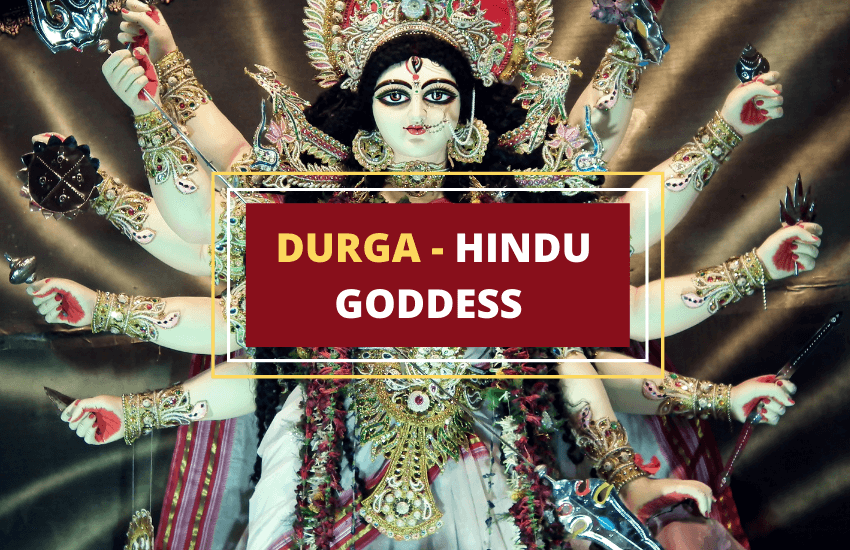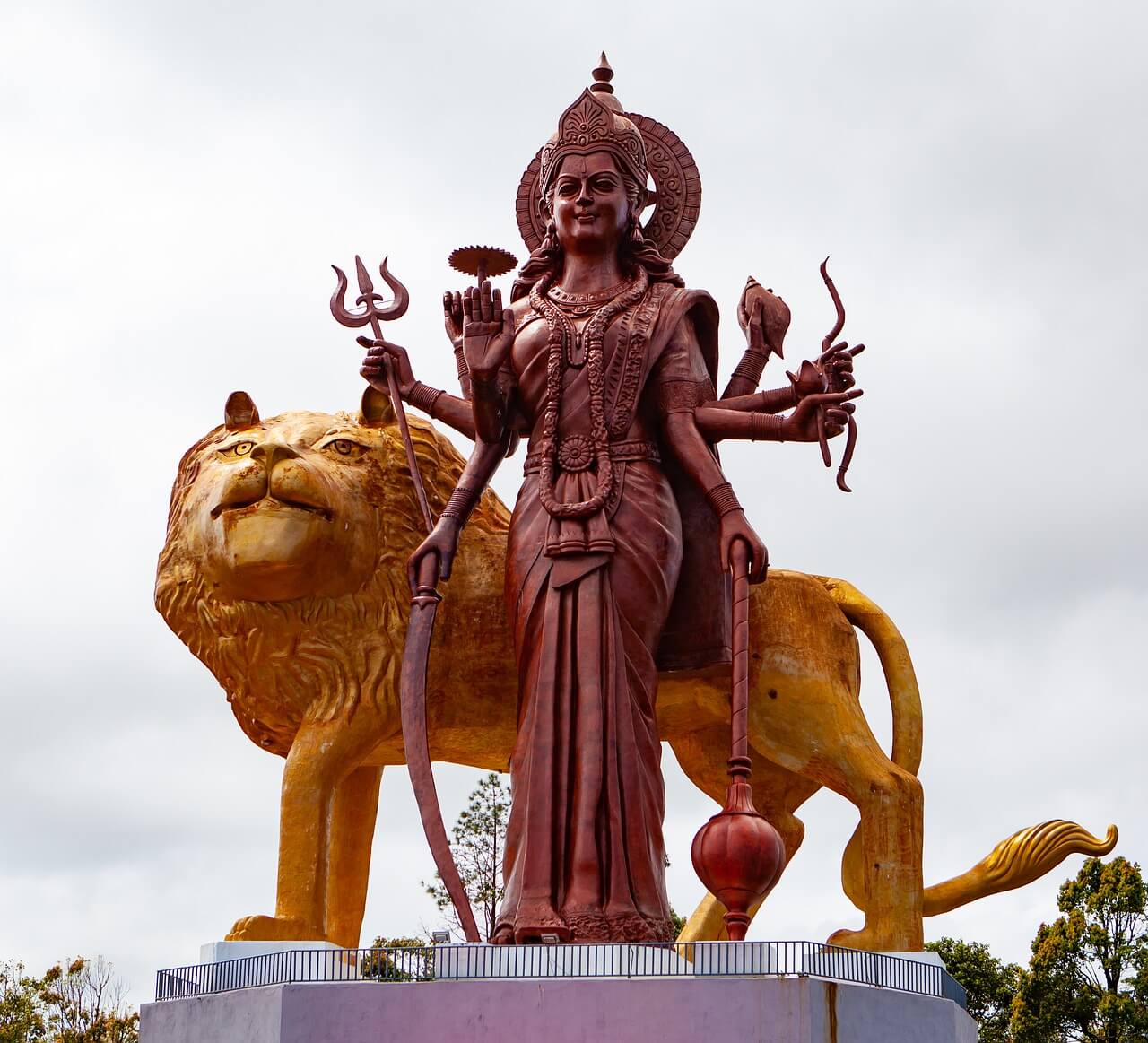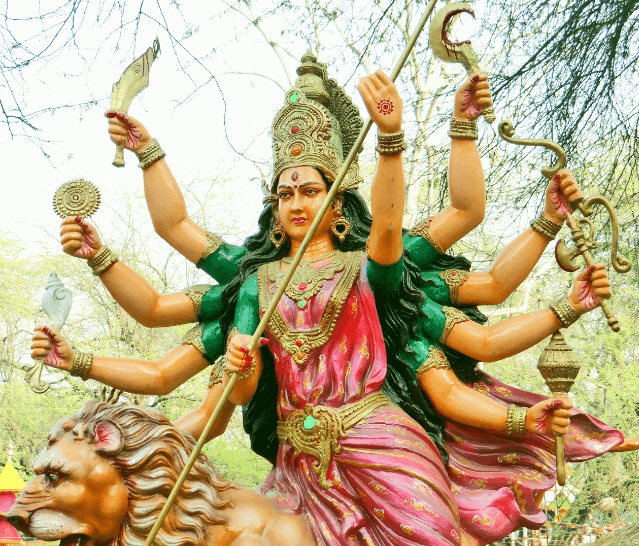
Table of Contents
Durga is one of the principal goddesses of Hinduism. Among the many roles she plays, she’s best known as the protective mother of the universe and for her eternal fight against the forces of evil. The divine wrath of this motherly goddess liberates the oppressed and empowers creation.
Who Is Durga?

Durga is the Hindu goddess of war and strength, an important aspect in Hinduism due to the many legends of the struggle between good and evil. Durga is one of the deities who is in eternal opposition to the forces of evil and fights against the demons.
The name Durga in Sanskrit means ‘a fort’, signifying a place difficult to take over. This represents her nature as an invincible, impassable and impossible to defeat goddess.
In most of her depictions, Durga appears riding a lion or a tiger towards battle. She has between eight and eighteen hands, with each one of them carrying a different weapon. Some depictions show Durga as a three-eyed goddess, in concordance with her consort, Shiva. Each one of the eyes represented a different domain.
Among the items that Durga carries, she’s commonly depicted with swords, a bow and arrows, a trident, a discus, a conch shell and a thunderbolt. Each one of these weapons is a part of Durga’s symbology. These weapons are essential for her fight against demons and her role as a protectress of the world.
History of Durga
Durga first appeared in the Rig Veda, one of the central and most ancient scriptures of Hinduism. According to the myths, Brahma, Vishnu, and Shiva created Durga to fight the buffalo demon Mahishasura. Many of her depictions show her in this event. Like most deities of this religion, Durga was born a grown woman and ready to delve into battle. She represents a threat and a menace for the forces of evil.
Like other deities of Hinduism, Durga had many incarnations in which she appeared on earth. Perhaps one of her most known forms was as Kali, the goddess of time and destruction. Apart from this incarnation, Durga also appeared on earth as Lalita, Gauri, Java, and many more. In many accounts, Durga was the consort of Shiva, one of the fundamental gods of the Hindu pantheon.
Durga and the Buffalo Demon
Mahishasura was a buffalo demon who served the god Brahma. After many years of servitude, Mahishasura asked Brahma for immortality. However, the god refused on the basis that all things must die one day.
The demon was enraged and started torturing people throughout the land. The deities of Hinduism created Durga to put an end to the creature. Durga, born fully formed, fought him riding on a tiger or a lion and carrying her many weapons. Mahishasura tried to attack Durga in many forms, but the goddess slew him in all of them. In the end, she killed him while he was transforming himself into a buffalo.
Who Are the Navadurga?
The Navadurga are the nine epithets of Durga. They are different goddesses that derive from Durga, and that represent her in several stories. They are nine deities in total, and each one of them has a separate celebration day in Hinduism. They are Skondamata, Kusumanda, Shailaputri, Kaalratri, Brahmacharini, Maha Gauri, Katyayani, Chandraghanta, and Siddhidatri.
Symbolism of Durga

Durga’s Weapons
Durga is shown holding several weapons and objects, each playing an important role in her symbolism.
- Conch Shell – This represents her connection with holiness. The shell symbolizes Pranava, the sound of Om, which in itself represents God.
- Bow and Arrow – This weapon symbolizes Durga’s power and control and signifies her role as a protector.
- Thunderbolt – This represents the firmness, belief in one’s convictions, and the will of the goddess. It’s a reminder to face challenges with confidence and to persevere on the path of righteousness.
- Lotus – The lotus flower that Durga holds is not fully bloomed. This represents the triumph not yet fully accomplished. The lotus also represents the triumph of good over evil, as the flower remains pure despite being mired in muck.
- Sword – The sword symbolizes knowledge and truth. Like the sword, knowledge is power and has the sharpness of a sword.
- Trident – The trident symbolizes the easing of mental, physical, and spiritual suffering.
Durga’s Form of Transport
Durga is depicted as sitting atop a lion or tiger as her mode of transportation. This was a marked representation of her strength. She was a force to be reckoned with and a fearless goddess. Her will was unmatched, and she represented the most ethical way to live without fear. The Hindus took this as a guide to follow the righteous path in life.
A Symbol of Protection
Durga was the primordial force of righteousness and goodness in the world. She symbolized protection and all that opposed the negative aspects of life. She was a positive symbol and an important force in the balance of life.
Worship of Durga in Modern Times
Durga’s festival is the Durga-puja and is one of the most celebrated festivals in northeastern India. This celebration lasts four days and is held yearly in September or October, depending on the Hindu lunisolar calendar. In this festival, the Hindus celebrate the win of Durga over the evil forces, and they offer prayers and songs to this mighty goddess.
Apart from the Durga-puja, Durga is celebrated on many other days of the year. She is also a central figure in the festival of Navrati and the harvests of Spring and Fall.
Durga’s worship spread from India to Bangladesh, Nepal, and Sri Lanka. She is a fundamental goddess in Buddhism, Jainism, and Sikhism. In this sense, Durga became an essential goddess throughout the Indian subcontinent.
In Brief
Durga is a beacon of the forces of good over evil. She remains one of the most important goddesses of Hinduism. To learn more about other Hindu gods, check out our article listing the most well-known deities of this religion.








